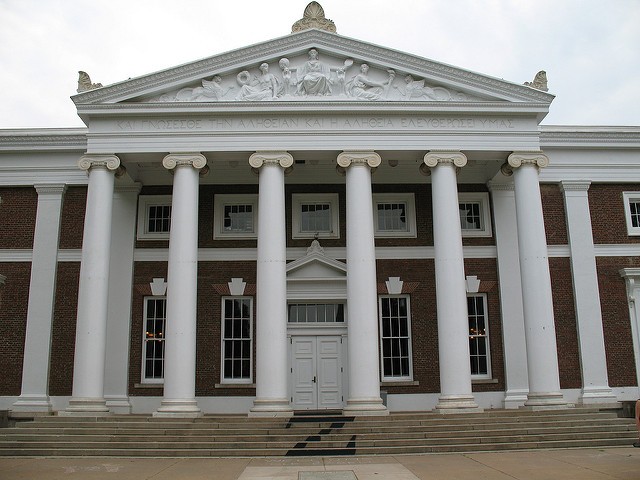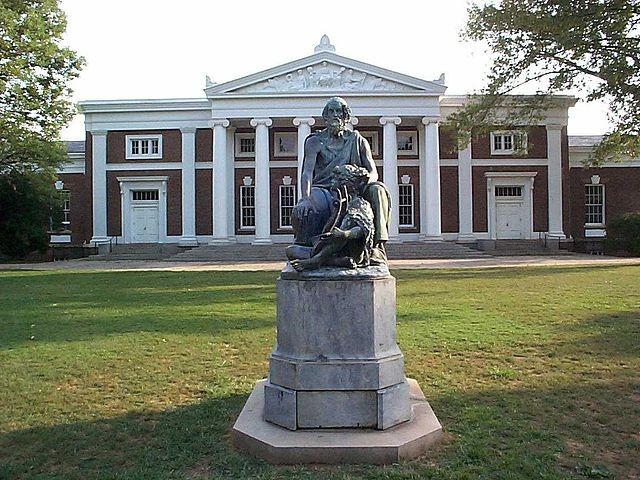Old Cabell Hall
Introduction
Text-to-speech Audio
Old Cabell Hall is located at the south end of the Lawn on the University of Virginia campus. Constructed between 1895 and 1898, this structure was intended to replace lost classroom and auditorium space following the Rotunda fire of 1895. Originally called the "Academical Building," it was renamed in 1898 in recognition of Joseph Carrington Cabell for his service to the university. "New" Cabell Hall wraps around the 1898 building. Today, Cabell houses the Hall McIntire Department of Music and the Music Library, in addition to the University's primary lecture and concert hall.
Images
Cabell Hall at the University of Virginia

Homer Sculpture in front of Old Cabell Hall

Backstory and Context
Text-to-speech Audio
Three days after the fire that destroyed the Rotunda and its attached classrooms (October 27, 1895), the Board of Visitors launched a program to rebuild the library and replace lost auditorium space. The proposed "Academical Building" was to contain a public hall in order to meet the latter need. Architect Stanford White of the New York firm McKim, Mead, and White was hired to design the new building. Construction on Cabell Hall completed in 1898 and the subsequently named after Joseph Carrington Cabell. Cabell was a friend of Thomas Jefferson and made significant contributions to the university.
"New" Cabell Hall, added in the 1950s, wraps around White's 1898 building. The exterior features a pediment sculpture by George J. Zolnay, completed in 1898. This sculpture is an allegorical piece based on John 8:16: "Ye shall know the truth, and the truth shall make you free."1 In front of the hall is a bronze sculpture of the poet Homer and his guide, created in 1907 by Moses J. Ezekiel.
Inside the structure is U.Va's primary concert and lecture hall, which hosts musical and speaking events—such as the 1998 appearance by the Dalai Lama. When it was constructed, the "public hall" had a capacity of 1,500 persons. The seats were made of molded plywood and divided into 600 seats below the railings and additional seating in the gallery, with standing room behind the railing and next to the wall. Subsequent renovations to improve accessibility and the quality of the seating, however, have shrunk the capacity to 851.
There are several notable works of art within Cabell Hall. Copied from the Rotunda Annex was a mural of Raphael's painting, School of Athens. The mural, created in 1902, was commissioned by an anonymous alumnus. It is the work of painter George W. Breck. In 2000, the University of Virginia added a mural by Lincoln Perry, entitled The Student's Progress. Perry's mural depicts a young woman's experience at U.Va. The Skinner Organ in the auditorium was gifted to the university in 1906 by Andrew Carnegie; it was dedicated during a recital by Samuel Baldwin on March 18, 1907.
"New" Cabell Hall, added in the 1950s, wraps around White's 1898 building. The exterior features a pediment sculpture by George J. Zolnay, completed in 1898. This sculpture is an allegorical piece based on John 8:16: "Ye shall know the truth, and the truth shall make you free."1 In front of the hall is a bronze sculpture of the poet Homer and his guide, created in 1907 by Moses J. Ezekiel.
Inside the structure is U.Va's primary concert and lecture hall, which hosts musical and speaking events—such as the 1998 appearance by the Dalai Lama. When it was constructed, the "public hall" had a capacity of 1,500 persons. The seats were made of molded plywood and divided into 600 seats below the railings and additional seating in the gallery, with standing room behind the railing and next to the wall. Subsequent renovations to improve accessibility and the quality of the seating, however, have shrunk the capacity to 851.
There are several notable works of art within Cabell Hall. Copied from the Rotunda Annex was a mural of Raphael's painting, School of Athens. The mural, created in 1902, was commissioned by an anonymous alumnus. It is the work of painter George W. Breck. In 2000, the University of Virginia added a mural by Lincoln Perry, entitled The Student's Progress. Perry's mural depicts a young woman's experience at U.Va. The Skinner Organ in the auditorium was gifted to the university in 1906 by Andrew Carnegie; it was dedicated during a recital by Samuel Baldwin on March 18, 1907.
Sources
1. "Old Cabell Hall." McIntire Department of Music. Accessed March 15, 2017. http://music.Virginia.edu/och.
"Cabell Hall." Albert and Shirley Small Special Collections Library. Accessed March 15, 2017. http://small.library.Virginia.edu/collections/featured/the-cabell-family-papers-2/cabells-at-uva/cab....
"Facilities." McIntire Department of Music. Accessed March 15, 2017. http://music.Virginia.edu/facilities.
"U.Va. Web Map: Old Cabell Hall." The University of Virginia. Accessed March 15, 2017. http://www.Virginia.edu/webmap/popPages/67-CabellOld.html.
"UVA Cabell Hall"; image by Mr.TinDC. http://www.flickr.com/photos/mr_t_in_dc/2690418771.
"Homer statue in front of Old Cabell Hall at the University of Virginia"; image by Philip LarsonStatue: Moses Jacob Ezekiel - flickr, CC BY-SA 2.0, https://commons.wikimedia.org/w/index.php?curid=3775752.
"Cabell Hall." Albert and Shirley Small Special Collections Library. Accessed March 15, 2017. http://small.library.Virginia.edu/collections/featured/the-cabell-family-papers-2/cabells-at-uva/cab....
"Facilities." McIntire Department of Music. Accessed March 15, 2017. http://music.Virginia.edu/facilities.
"U.Va. Web Map: Old Cabell Hall." The University of Virginia. Accessed March 15, 2017. http://www.Virginia.edu/webmap/popPages/67-CabellOld.html.
"UVA Cabell Hall"; image by Mr.TinDC. http://www.flickr.com/photos/mr_t_in_dc/2690418771.
"Homer statue in front of Old Cabell Hall at the University of Virginia"; image by Philip LarsonStatue: Moses Jacob Ezekiel - flickr, CC BY-SA 2.0, https://commons.wikimedia.org/w/index.php?curid=3775752.
